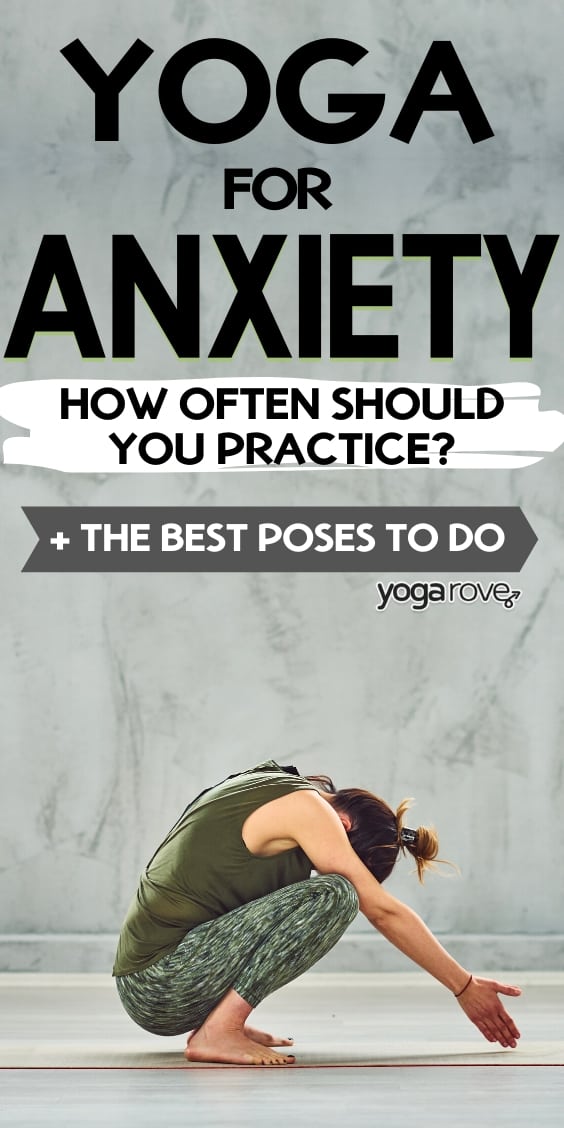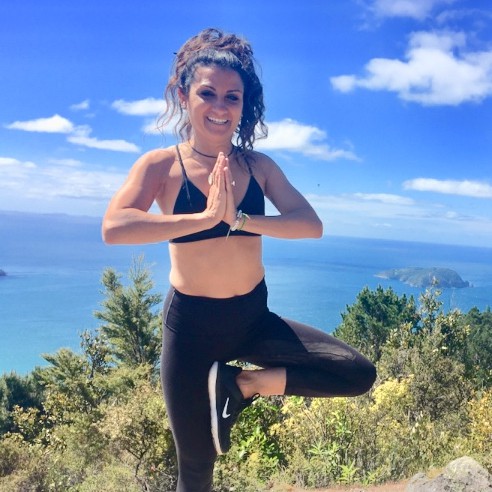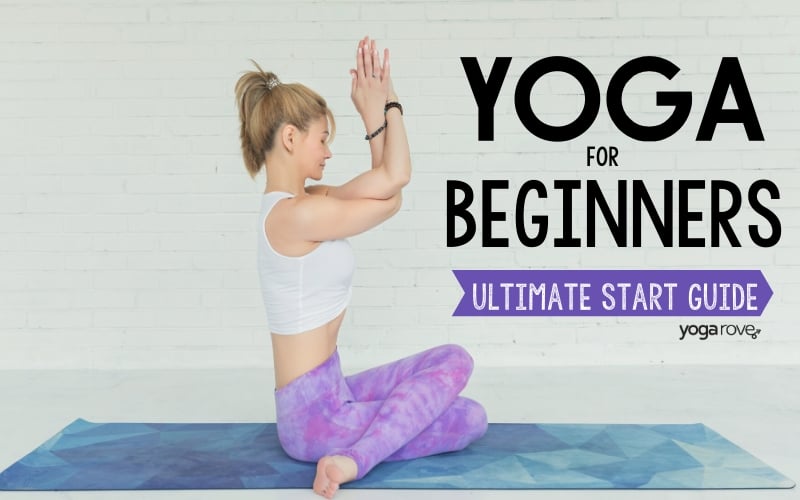This post may contain affiliate links. Please read our disclosure for more info.
As a yoga teacher who experiences anxiety on a daily basis, I often get asked if yoga helps anxiety. I can honestly say that for me, yoga has helped me manage my symptoms for the past 5 years.

How often should you practice yoga for anxiety?
- practicing as little as ten minutes a day can be beneficial for anxiety sufferers.
- having a 1 hour yoga practice 2-3 times a week can dramatically decrease your symptoms.
- according to research done by the Johns Hopkins University, the most effective way to combat anxiety and depression is to do 20-30 minutes of daily mindfulness meditation.
- If you experience anxiety prior to a potentially stressful situation, like a job interview, first date or a public speaking commitment, practice yoga 2-3 hours before the event and If you are still anxious right before the occasion, take 10 – 15 minutes to mediate and breath.
Regardless of how or why you experience it, anxiety can disrupt your daily life – if you let it.
There are many ways to combat anxiety and yoga is one of the most effective. Especially when you integrate meditation and breathing exercises with physical yoga poses.
What Exactly is Anxiety?
Anxiety and panic disorders are arguably the most common type of mental illness today. Some people experience it on a daily basis with seemingly no explanation and others experience it situationally or in response to a stressful life event.
There are so many types of anxiety like generalized anxiety, social anxiety, obsessive compulsive disorder, post traumatic stress disorder and panic disorder. These anxieties cause many different mental and physical symptoms.
Yoga can instantly relieve the physical symptoms caused by anxiety. These symptoms include but are not limited to:
- Excessive thoughts or obsessions
- Restlessness
- Racing heart
- Vomiting or nausea
- Dizziness
- Excessive sweating
- Overwhelming fear of dying
- Overwhelming feeling of going crazy
- Derealization
- Depersonalization
- Difficulty sleeping
- Difficulty focusing
- Chest pains
- Weakness
- Hyperventilating
- Extreme tiredness
- Feeling lightheaded
- Shaking, trembling hands
- A tingly or numb feeling in your hands and feet
Can Yoga Help With Anxiety?
Absolutely.
Many research studies have explored the benefits of yoga and meditation, specifically the way it helps with anxiety. Yoga has been proven to reduce the physical symptoms that come along with stressful and overwhelming situations. Any amount of yoga and meditation will be beneficial in managing symptoms.
Yoga teaches you to be present. This allows you to stop focusing on the past or worrying about the future, which is a big factor in creating anxiety.
The best thing about yoga and meditation is that there are no known negative side effects.
What Type of Yoga is Best for Anxiety?
The best type of yoga for anxiety is a combination of physical asanas and a meditation practice is the most powerful way to regulate and control anxiety.
Asanas are the physical yoga poses like downward facing dog and warrior poses. They can help reduce the physical components of anxiety and anxiety attacks.
For example, when you are anxious, your body tends to tense up – creating aches and pains in such places as your neck and back. Practicing asanas relieves and releases the tension that has built up.
A really common practice is to link asanas with breath and movement. This creates a continuous flow between poses producing feel good chemicals like endorphins, oxytocin, serotonin, and dopamine. After a solid practice, your body should be tired enough to sit in meditation.
We will be going over the best type of yoga poses to relieve anxiety below.
The combination of yoga and meditation helps by:
- calming down your nervous system
- reducing your heart rate
- refocusing your brain
It also enhances mindfulness by teaching you to check in with your body, as well as your emotions.
Different Types of Effective Breathing Techniques to Reduce Anxiety
Breathing is an essential part of yoga. There are different types of breathing exercises and one of the most common is Ujjayi Breath. Ujjayi Breath is also known as ocean breath or victorious breath. This breath can be done anywhere and at any time which is ideal for anxiety sufferers.
Follow the steps below to practice Ujjayi Breath:
- Close your mouth and press your lips together.
- Slowly inhale through your nose while constricting your throat muscles.
- Fill your lungs all the way up – until there is no more space for air.
- Slowly start to exhale through your nose.
Ujjayi Breath is instantly effective and as stated before can be done anywhere at any time. Ujjayi has many other benefits which include:
- Decreasing heart rate
- Increasing the oxygen in your blood
- Boosts energy levels
- Improves focus
- calms nerves
- Detoxes mind
- Detoxes body
- Promotes self awareness
- Boosts immune system
- Connects mind and body
- Improves memory
- Calms and relaxes mind and body
But there are also many different other types of breathing techniques that can help calm your anxiety. Two other popular ones are:
The 4-7-8 Method:
- Close your mouth and inhale quietly through your nose to a mental count of four.
- Hold your breath for a count of seven.
- Exhale completely through your mouth, making a whoosh sound to a count of eight.
Repeat as many times as you need to. The 4,7,8 method:
- Calms the parasympathetic nervous system.
- Calms the mind
- Reduces heart rate
- Reduces blood pressure
- Improves blood flow
- Reduces stress
The “Breath Counting” Technique:
- Start counting your exhales.
- Once you get to five, restart
- If you notice you’ve gone past five exhales, try refocusing your attention to your breath
This exercise really helps your awareness and attention. Especially when you have racing, obsessive thoughts.
The Best Yoga Poses to Combat Anxiety
Although physical yoga asanas themselves are beneficial in reducing anxiety, there are certain poses that have been known to help find quicker relief.
Child’s Pose
A resting pose that promotes a calm mind and body.
- Bring your knees to the edges of your mat
- Walk your fingertips to the top of your mat
- Press your palms down and spread your fingers wide
- Drop your chest to the ground
- Press your forehead down
- Begin Ujjayi Breath
Cat/Cow Pose
Relieves tension in the spine and shoulders caused by anxiety.
- Start on all fours
- Bring your hands shoulder width apart
- Bring your knees hips width apart
- Make your spine neutral
- Inhale to cow by dropping your stomach towards the mat, lifting your gaze and chest up – squeeze your shoulders together
- Exhale to cat by spreading your shoulders apart and lifting your spine towards the ceiling
Ragdoll Pose
Relieves tension in your neck and fills your brain with fresh blood promoting a calming energy.
- Stand with your feet hips width distance apart
- Bend at your hips, dropping your head towards the ground
- Bring a small ( or big) bend in your knees
- Bring your hands to opposite arm
- Breath
Tree Pose
Teaches balance and focus.
- Press your left foot firmly into your mat.
- Bring a small bend into your left knee.
- Bring your right foot to your ankle, outer shin or thigh (anywhere above or below your knee)
- Point your toes to the ground
- Press your palms together, fingers spread wide
- Press your shoulders back
- Set your gaze on one spot in front of you
- Breath
Supported Bridge
Relaxes and stretches the spine, releasing tension created from anxiety.
- Lay flat on your back
- Bend your knees, bringing you heels townrds your butt.
- Lift your hips to the sky
- Place a block/blanket or your hands under your lower back.
- Let your body melt over the block
- Close your eyes
- Focus on breath
Legs Up The Wall Pose
Relieves tension in the lower back, reverses blood flow and produces a calming effect.
- Bring your mat to the edge of any wall
- Scoot your butt against the wall
- Raise your legs straight up against the wall
- Consider using a blanket or bolster under your lower back
- Bring your hands by your sides, palms facing up
- Close your eyes
- Focus on the rise and fall of your chest as you breath
Savasana
Promotes full body and mind relaxation.
- Lay flat on the ground, arms and legs wide
- Let your arms lay by your sides, palms facing up
- Close your eyes and focus on your breath
- If your mind keeps racing, bring one heart on your hand and one on your belly
- Focus your thoughts on the rise and fall of your chest as you breath
After you complete these physical asanas, you should be primed to be able to sit in meditation, even if it’s just for one minute!
Don’t worry if you’ve never meditated before, just started with one minute of meditation a day will make a world of a difference in how you feel.
To begin your meditation:
- Sit on your bottom with your legs crossed
- Lift your head high
- Press your shoulders down and back
- Bring your hands to your knees letting your palms face the sky
- Close your eyes
- Focus on breath
- Your thoughts may wander and that is okay, when you realize it, just refocus on breath
If you try this out and it just doesn’t feel like it’s for you, you can also try starting out with a guided meditation.
I would love for you to challenge yourself and try to practice even just a few of these yoga poses every time you begin to feel anxious, as well as implement at least one minute of meditation every day.
I would love to hear your results in the comments below!







I have been doing yoga twice a week with a private instructor. I absolutely love it. It for sure helps me on those days. Should one practice every day? I have terrible anxiety and panic attack
Tree, downward dog, child’s pose, ragdoll cat cow, lotus and savasana are my go tos always. I sometimes feel like I’m not doing enough because I don’t have a cool flow or do things that are hard on my body, but since I practice to ease my anxiety and get excercise at the same time, I feel confirmed now that I’m doing what’s best for me. Thank you for this.
I’m glad you found it helpful Tiffany- I completely agree just listen to your body. I used to think the same way with thinking that I needed to do an intense flow everytime I practiced, but sometimes a gentle, slower paced flow is just what our bodies need 🙂